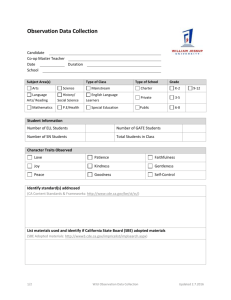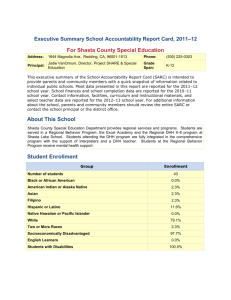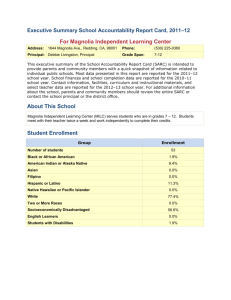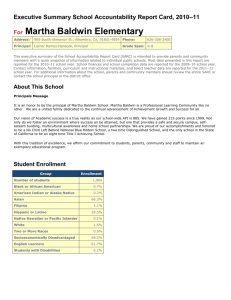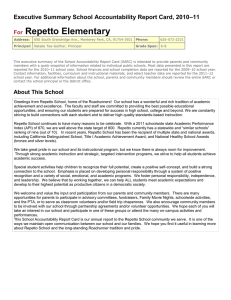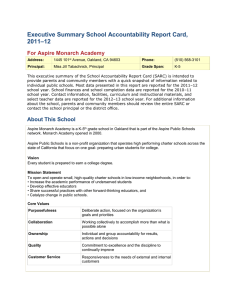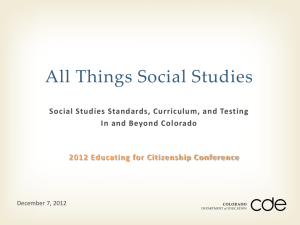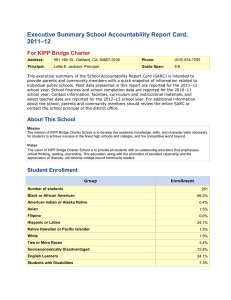English - Oakland Unified School District
advertisement
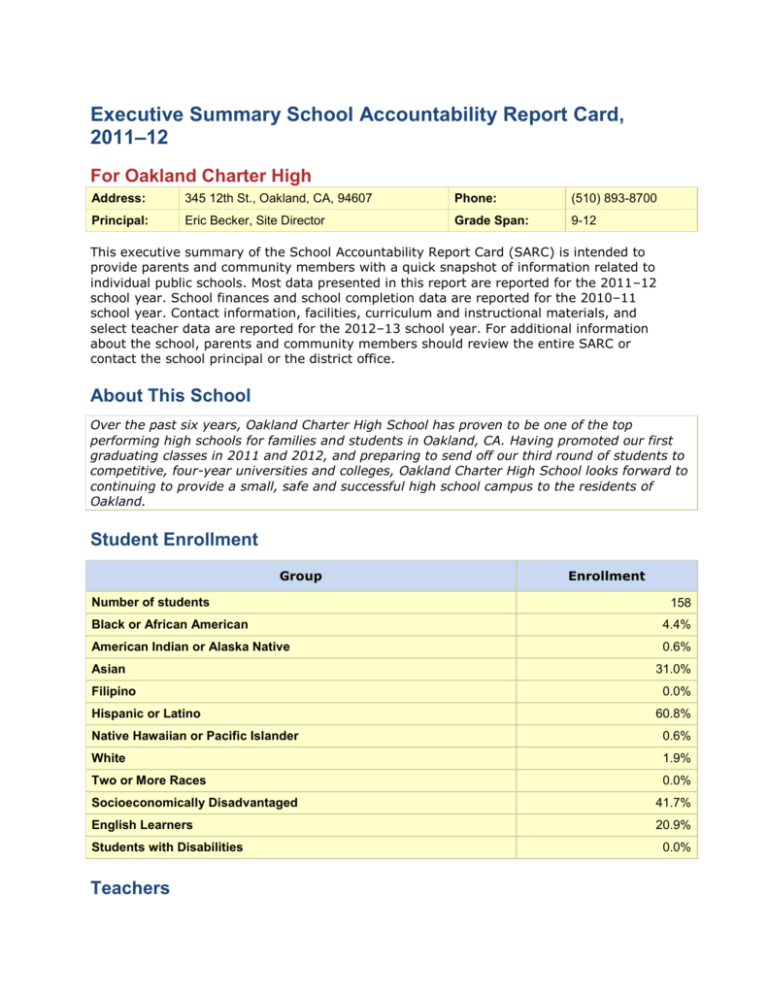
Executive Summary School Accountability Report Card, 2011–12 For Oakland Charter High Address: 345 12th St., Oakland, CA, 94607 Phone: (510) 893-8700 Principal: Eric Becker, Site Director Grade Span: 9-12 This executive summary of the School Accountability Report Card (SARC) is intended to provide parents and community members with a quick snapshot of information related to individual public schools. Most data presented in this report are reported for the 2011–12 school year. School finances and school completion data are reported for the 2010–11 school year. Contact information, facilities, curriculum and instructional materials, and select teacher data are reported for the 2012–13 school year. For additional information about the school, parents and community members should review the entire SARC or contact the school principal or the district office. About This School Over the past six years, Oakland Charter High School has proven to be one of the top performing high schools for families and students in Oakland, CA. Having promoted our first graduating classes in 2011 and 2012, and preparing to send off our third round of students to competitive, four-year universities and colleges, Oakland Charter High School looks forward to continuing to provide a small, safe and successful high school campus to the residents of Oakland. Student Enrollment Group Number of students Enrollment 158 Black or African American 4.4% American Indian or Alaska Native 0.6% Asian Filipino Hispanic or Latino 31.0% 0.0% 60.8% Native Hawaiian or Pacific Islander 0.6% White 1.9% Two or More Races 0.0% Socioeconomically Disadvantaged 41.7% English Learners 20.9% Students with Disabilities Teachers 0.0% Indicator Teachers Teachers with full credential 6 Teachers without full credential 2 Teachers Teaching Outside Subject Area of Competence 0 Misassignments of Teachers of English Learners 0 Total Teacher Misassignments 0 Student Performance Subject Students Proficient and Above on STAR* Program Results English-Language Arts 88% Mathematics 88% Science 89% History-Social Science 90% *Standardized Testing and Reporting Program assessments used for accountability purposes include the California Standards Tests, the California Modified Assessment, and the California Alternate Performance Assessment. Academic Progress* Indicator Result 2012 Growth API Score (from 2012 Growth API Report) 956 Statewide Rank (from 2011 Base API Report) 10 Met All 2012 AYP Requirements Number of AYP Criteria Met Out of the Total Number of Criteria Possible 2012–13 Program Improvement Status (PI Year) Yes Met 5 of 5 NA *The Academic Performance Index is required under state law. Adequate Yearly Progress is required by federal law. School Facilities Summary of Most Recent Site Inspection OCHS moved into the current building in the summer of 2009. At this time all the needed repairs and improvements were been performed. The building is regularly cleaned and maintained. Repairs Needed None at this time Corrective Actions Taken or Planned None at this time Curriculum and Instructional Materials Pupils Who Lack Textbooks and Instructional Materials Core Curriculum Area Reading/Language Arts 0 Mathematics 0 Science 0 History-Social Science 0 Foreign Language 0 Health 0 Visual and Performing Arts 0 Science Laboratory Equipment (grades 9-12) 0 School Finances Level Expenditures Per Pupil (Unrestricted Sources Only) School Site $7,890.00 District LEA Provided State $5,455 School Completion Indicator Result Graduation Rate (if applicable) 92.31 Postsecondary Preparation Measure Percent Pupils Who Completed a Career Technical Education Program and Earned a High School Diploma NA Graduates Who Completed All Courses Required for University of California or California State University Admission 100.0% School Accountability Report Card Reported Using Data from the 2011–12 School Year Published During 2012–13 Every school in California is required by state law to publish a School Accountability Report Card (SARC), by February 1 of each year. The SARC contains information about the condition and performance of each California public school. For more information about SARC requirements, see the California Department of Education (CDE) SARC Web page at http://www.cde.ca.gov/ta/ac/sa/. For additional information about the school, parents and community members should contact the school principal or the district office. I. Data and Access Ed-Data Partnership Web Site Ed-Data is a partnership of the CDE, EdSource, and the Fiscal Crisis and Management Assistance Team (FCMAT) that provides extensive financial, demographic, and performance information about California’s public kindergarten through grade twelve school districts and schools. DataQuest DataQuest is an online data tool located on the CDE DataQuest Web page at http://dq.cde.ca.gov/dataquest/ that contains additional information about this school and comparisons of the school to the district, the county, and the state. Specifically, DataQuest is a dynamic system that provides reports for accountability (e.g., state Academic Performance Index [API], federal Adequate Yearly Progress [AYP]), test data, enrollment, high school graduates, dropouts, course enrollments, staffing, and data regarding English learners. Internet Access Internet access is available at public libraries and other locations that are publicly accessible (e.g., the California State Library). Access to the Internet at libraries and public locations is generally provided on a first-come, first-served basis. Other use restrictions may include the hours of operation, the length of time that a workstation may be used (depending on availability), the types of software programs available on a workstation, and the ability to print documents. II. About This School Contact Information (School Year 2012–13) School District School Name Oakland Charter High District Name Oakland Unified Street 345 12th St. Phone Number (510) 879-8582 City, State, Zip Oakland, CA, 94607 Web Site www.ousd.k12.ca.us Phone Number (510) 893-8700 Superintendent Anthony Smith Principal Eric Becker, Site Director E-mail Address tony.smith@ousd.k12.ca.us E-mail Address ebecker@amethodschools.org CDS Code 01612590114868 School Description and Mission Statement (School Year 2011–12) The goal of Amethod Public Schools is to provide a fundamental and rigorous college preparatory education to any student that chooses one of our schools. We believe that successful life in modern society can be achieved through college education, especially for historically disenfranchised populations. All AMPS graduates will have gone through a challenging academic and character development program that will ready graduates to enter and succeed in college, and provide options for future endeavors. Opportunities for Parental Involvement (School Year 2011–12) Parents are informed regularly of their student’s progress: every three weeks. When a student is under performing parents are asked to come in for a conference with the principal and academic advisor. Parents attend at minimum, (2) parent information meetings where topics such as the value of a college education, college admission process and A-G requirements are discussed and presented. Most importantly, we encourage parents to become involved in their children’s education at home by assuring that their child is completing their assigned work, preparing a healthy lunch for their child, and by making sure that their child leaves home for school at an appropriate time. Student Enrollment by Grade Level (School Year 2011–12) Grade Level Number of Students Grade Level Number of Students Kindergarten 0 Grade 8 0 Grade 1 0 Ungraded Elementary 0 Grade 2 0 Grade 9 59 Grade 3 0 Grade 10 36 Grade 4 0 Grade 11 31 Grade 5 0 Grade 12 32 Grade 6 0 Ungraded Secondary Grade 7 0 Total Enrollment 0 158 Student Enrollment by Student Group (School Year 2011-12) Group Black or African American Percent of Total Enrollment 4.4% American Indian or Alaska Native 0.6% Asian 31.0% Filipino 0.0% Hispanic or Latino 60.8% Native Hawaiian or Pacific Islander 0.6% White 1.9% Two or More Races 0.0% Socioeconomically Disadvantaged 41.7% English Learners 20.9% Students with Disabilities 0.0% Average Class Size and Class Size Distribution (Elementary) Grade Level Avg. Class Size 2009–10 Number of Classes* 120 2132 33+ Avg. Class Size 2010–11 Number of Classes* 120 2132 33+ Avg. Class Size 2011–12 Number of Classes* 120 2132 33+ K 1 2 3 4 5 6 Other * Number of classes indicates how many classes fall into each size category (a range of total students per classroom). Average Class Size and Class Size Distribution (Secondary) Subject Avg. Class Size 2009–10 Number of Classes* 122 2332 33+ Avg. Class Size 2010–11 Number of Classes* 122 2332 33+ Avg. Class Size 2011–12 Number of Classes* 122 2332 English 18.6 5 17.1 7 22.5 4 3 Mathematics 18.6 5 17.1 7 19.7 6 2 Science 18.6 5 17.1 7 19.7 6 2 33+ Social Science 18.6 5 17.1 7 22.5 4 3 * Number of classes indicates how many classrooms fall into each size category (a range of total students per classroom). At the secondary school level, this information is reported by subject area rather than grade level. III. School Climate School Safety Plan (School Year 2011–12) The safety and security of our students and staff are top priorities for Amethod Public Schools (AMPS). This booklet explains some of the procedures that have been planned and practiced in the event of an emergency at your child’s school. School administrators will seek to work closely with police, fire, emergency services and public health to ensure our Safety & Crisis Manual reflects appropriate practices and all schools are prepared for emergencies. Amethod Public Schools takes an all-hazards approach to emergency readiness. We are prepared to work in partnership with emergency responders should a critical incident occur in one of our schools. Our comprehensive emergency plan addresses a multitude of potential incidents, not because we expect them to occur, but because we want to be prepared in case they do. For security reasons, specific details are not made available to the public; however, parents and students have a vital role and it is important that you know what to do in an emergency. Please review information in our booklet, which is available on our website at www.amethodschools.org. Suspensions and Expulsions Rate* School 2009–10 School 2010–11 School 2011–12 District 2009–10 District 2010–11 District 2011–12 Suspensions 2 2 1.3% (2) 14.79% 14.16% 12.26% Expulsions 0 0 0 0.15% 0.16% 0.19% * The rate of suspensions and expulsions is calculated by dividing the total number of incidents by the total enrollment. IV. School Facilities School Facility Conditions and Planned Improvements (School Year 2012–13) OCHS moved into the current building in the summer of 2009. At this time all the needed repairs and improvements had been performed. The building is regularly cleaned and maintained. School Facility Good Repair Status (School Year 2012–13) Repair Status System Inspected Exemplary Systems: Gas Leaks, Mechanical/HVAC, Sewer Good X Fair Poor Repair Needed and Action Taken or Planned Maintenance performed twice a year. Recent HVAC inspection 11/11/2011 PG&E Interior: Interior Surfaces X Cleaned daily Cleanliness: Overall Cleanliness, Pest/ Vermin Infestation X Excellent, maintained by a cleaning service Electrical: Electrical X No known issues Restrooms/Fountains: Restrooms, Sinks/ Fountains X No known issues Safety: Fire Safety, Hazardous Materials X Fire Alarms and Extinguishers checked in 9/22/2012 Structural: Structural Damage, Roofs X No known issues External: Playground/School Grounds, Windows/ Doors/Gates/Fences X Trees trimmed on the black-top playground area. Maintenance performed regularly Overall Rating X Note: Cells shaded in black do not require data. V. Teachers Teacher Credentials Teachers School 2009–10 School 2010–11 School 2011–12 District 2011–12 With Full Credential 4 4 5 Without Full Credential 2 3 2 Teaching Outside Subject Area of Competence (with full credential) 0 0 0 Teacher Misassignments and Vacant Teacher Positions Indicator 2010–11 2011–12 2012–13 Misassignments of Teachers of English Learners 0 0 0 Total Teacher Misassignments* 0 0 0 Vacant Teacher Positions 0 0 0 Note: “Misassignments” refers to the number of positions filled by teachers who lack legal authorization to teach that grade level, subject area, student group, etc. * Total Teacher Misassignments includes the number of Misassignments of Teachers of English Learners. Core Academic Classes Taught by Highly Qualified Teachers (School Year 2011–12) The Federal Elementary and Secondary Education Act (ESEA), also known as No Child Left Behind (NCLB), requires that core academic subjects be taught by Highly Qualified Teachers, defined as having at least a bachelor’s degree, an appropriate California teaching credential, and demonstrated core academic subject area competence. For more information, see the CDE Improving Teacher and Principal Quality Web page at: http://www.cde.ca.gov/nclb/sr/tq/ Percent of Classes In Core Academic Subjects Taught by Highly Qualified Teachers Location of Classes Percent of Classes In Core Academic Subjects Not Taught by Highly Qualified Teachers This School 100.00% 0.00% All Schools in District 100.00% 0.00% High-Poverty Schools in District Low-Poverty Schools in District Note: High-poverty schools are defined as those schools with student eligibility of approximately 40 percent or more in the free and reduced price meals program. Low-poverty schools are those with student eligibility of approximately 25 percent or less in the free and reduced price meals program. VI. Support Staff Academic Counselors and Other Support Staff (School Year 2011–12) Title Number of FTE* Assigned to School Academic Counselor 1 Counselor (Social/Behavioral or Career Development) 1 Library Media Teacher (librarian) N/A Library Media Services Staff (paraprofessional) N/A Psychologist 0.1 Social Worker N/A Nurse N/A Speech/Language/Hearing Specialist N/A Resource Specialist (non-teaching) 0.2 Student Study Team Coordinator 0.2 Average Number of Students per Academic Counselor Note: Cells shaded in black do not require data. * One Full-Time Equivalent (FTE) equals one staff member working full-time; one FTE could also represent two staff members who each work 50 percent of full-time. VII. Curriculum and Instructional Materials 30 Quality, Currency, Availability of Textbooks and Instructional Materials (School Year 2012–13) This section describes whether the textbooks and instructional materials used at the school are from the most recent adoption; whether there are sufficient textbooks and instruction materials for each student; and information about the school’s use of any supplemental curriculum or non-adopted textbooks or instructional materials. Year and month in which data were collected: _______12/12_____________ Core Curriculum Area Reading/Language Arts Mathematics Science History-Social Science Foreign Language Health Visual and Performing Arts Science Laboratory Equipment (grades 912) Textbooks and instructional materials/year of adoption From most recent adoption? Percent students lacking own assigned copy Good and available to all. Texts are state board approved. List through 2012-2013 school year. Good and available to all. Texts are state board approved. List through 2012-2013 school year. Good and available to all. Texts are state board approved. List through 2012-2013 school year. Good and available to all. Texts are state board approved. List through 2012-2013 school year. Good and available to all. Texts are state board approved. List through 2012-2013 school year. Good and available to all. Texts are state board approved. List through 2012-2013 school year. Good and available to all. Texts are state board approved. List through 2012-2013 school year. Good and available to all. Texts are state board approved. List through 2012-2013 school year. We follow SBE adopted Regulations 0 We follow SBE adopted Regulations 0 We follow SBE adopted Regulations 0 We follow SBE adopted Regulations 0 We follow SBE adopted Regulations 0 We follow SBE adopted Regulations 0 We follow SBE adopted Regulations 0 We follow SBE adopted Regulations 0 VIII. School Finances Expenditures Per Pupil and School Site Teacher Salaries (Fiscal Year 2010–11) Level School Site Total Expenditures Per Pupil $8,544.00 Expenditures Per Pupil (Supplemental / Restricted) $654.00 Expenditures Per Pupil (Basic / Unrestricted) Average Teacher Salary $7,890.00 $45,000 District LEA Provided $54,035 Percent Difference – LEA Provided 16.73% School Site and District State Percent Difference – School Site and State $5,455 $68,835 LEA Provided 34.63% Note: Cells shaded in black do not require data. Supplemental/Restricted expenditures come from money whose use is controlled by law or by a donor. Money that is designated for specific purposes by the district or governing board is not considered restricted. Basic/unrestricted expenditures are from money whose use, except for general guidelines, is not controlled by law or by a donor. For detailed information on school expenditures for all districts in California, see the CDE Current Expense of Education & Per-pupil Spending Web page at http://www.cde.ca.gov/ds/fd/ec/. For information on teacher salaries for all districts in California, see the CDE Certificated Salaries & Benefits Web page at http://www.cde.ca.gov/ds/fd/cs/. To look up expenditures and salaries for a specific school district, see the Ed-Data Web site at: http://www.ed-data.org. Types of Services Funded (Fiscal Year 2011–12) Oakland Charter High School offers a tutoring program throughout the day for students who score below a Basic level in a given subject. We also offer a two hour after school program for students who may be falling behind in content areas. We also have a mandatory 3 week summer school program for all students. Saturday schools are also ongoing throughout the year. OCHS also provides supplemental instruction in SAT test taking skills and funds for the testing fees. For our high performing students, OCHS also funds their participation in summer college programs such as Johns Hopkins University (CTY) Program, and UC Berkeley’s Academic Talent Development Program. Teacher and Administrative Salaries (Fiscal Year 2010–11) Category District Amount State Average For Districts In Same Category Beginning Teacher Salary $39,456 $41,455 Mid-Range Teacher Salary $54,328 $66,043 Highest Teacher Salary $70,934 $85,397 Average Principal Salary (Elementary) $84,669 $106,714 Average Principal Salary (Middle) $85,411 $111,101 Average Principal Salary (High) $86,249 $121,754 $265,000 $223,357 29.00% 39.00% 7.00% 5.00% Superintendent Salary Percent of Budget for Teacher Salaries Percent of Budget for Administrative Salaries Note: For detailed information on salaries, see the CDE Certificated Salaries & Benefits Web page at http://www.cde.ca.gov/ds/fd/cs/. IX. Student Performance Standardized Testing and Reporting Program The Standardized Testing and Reporting (STAR) Program consists of several key components, including: California Standards Tests (CSTs), which include English-language arts (ELA) and mathematics in grades two through eleven; science in grades five, eight, and nine through eleven; and history-social science in grades eight, and nine through eleven. California Modified Assessment (CMA), an alternate assessment that is based on modified achievement standards in ELA for grades three through eleven; mathematics for grades three through seven, Algebra I, and Geometry; and science in grades five and eight, and Life Science in grade ten. The CMA is designed to assess those students whose disabilities preclude them from achieving grade-level proficiency on an assessment of the California content standards with or without accommodations. California Alternate Performance Assessment (CAPA), includes ELA and mathematics in grades two through eleven, and science for grades five, eight, and ten. The CAPA is given to those students with significant cognitive disabilities whose disabilities prevent them from taking either the CSTs with accommodations or modifications or the CMA with accommodations. The assessments under the STAR Program show how well students are doing in relation to the state content standards. On each of these assessments, student scores are reported as performance levels. For detailed information regarding the STAR Program results for each grade and performance level, including the percent of students not tested, see the CDE STAR Results Web site at http://star.cde.ca.gov. Standardized Testing and Reporting Results for All Students – Three-Year Comparison Percent of Students Scoring at Proficient or Advanced (meeting or exceeding the state standards) Subject School District State 2009– 10 2010– 11 2011– 12 2009– 10 2010– 11 2011– 12 2009– 10 2010– 11 2011– 12 EnglishLanguage Arts 91% 87% 88% 43% 45% 47% 52% 54% 56% Mathematics 89% 86% 88% 44% 46% 46% 48% 50% 51% Science 94% 100% 89% 41% 46% 49% 54% 57% 60% HistorySocial Science 88% 74% 90% 27% 32% 31% 44% 48% 49% Note: Scores are not shown when the number of students tested is ten or less, either because the number of students in this category is too small for statistical accuracy or to protect student privacy. Standardized Testing and Reporting Results by Student Group – Most Recent Year Percent of Students Scoring at Proficient or Advanced Group EnglishLanguage Arts Mathematics Science History- Social Science All Students in the LEA 88% 88% 89% 90% All Students at the School 88% 88% 89% 90% Male 89% 91% 90% 89% Female 87% 87% 86% 90% 0% 0% 0% 0% 97% 94% 0% 93% 87% 87% 92% 90% Native Hawaiian or Pacific Islander 0% 0% 0% 0% White 0% 0% 0% 0% Two or More Races 0% 0% 0% 0% Socioeconomically Disadvantaged 90% 89% 88% 91% English Learners 80% 85% 0% 92% Students with Disabilities 0% 0% 0% 0% Students Receiving Migrant Education Services 0% 0% 0% 0% Black or African American American Indian or Alaska Native Asian Filipino Hispanic or Latino Note: Scores are not shown when the number of students tested is ten or less, either because the number of students in this category is too small for statistical accuracy or to protect student privacy. California High School Exit Examination The California High School Exit Examination (CAHSEE) is primarily used as a graduation requirement. However, the grade ten results of this exam are also used to establish the percentages of students at three proficiency levels (not proficient, proficient, or advanced) in ELA and mathematics to compute AYP designations required by the federal ESEA, also known as NCLB. For detailed information regarding CAHSEE results, see the CDE CAHSEE Web site at http://cahsee.cde.ca.gov/. California High School Exit Examination Results for All Grade Ten Students – Three-Year Comparison (if applicable) Percent of Students Scoring at Proficient or Advanced School Subject District State 2009– 10 2010– 11 2011– 12 2009– 10 2010– 11 2011– 12 2009– 10 2010– 11 2011– 12 EnglishLanguage Arts 94% 87% 97% 35% 40% 39% 54% 59% 56% Mathematics 94% 100% 11% 36% 40% 44% 54% 56% 58% Note: Scores are not shown when the number of students tested is ten or less, either because the number of students in this category is too small for statistical accuracy or to protect student privacy. California High School Exit Examination Grade Ten Results by Student Group – Most Recent Year (if applicable) English-Language Arts Group Mathematics Not Proficient Proficient Advanced Not Proficient Proficient Advanced All Students in the LEA 14% ND ND 3% ND ND All Students at the School 14% ND ND 3% ND ND Male 15% ND ND 5% ND ND Female 13% ND ND 0% ND ND Black or African American 0% ND ND 0% ND ND American Indian or Alaska Native NA NA NA NA NA NA Asian 0% ND ND 0% ND ND Filipino NA NA NA NA NA NA Hispanic or Latino 12% ND ND 4% ND ND Native Hawaiian or Pacific Islander NA NA NA NA NA NA White 0% ND ND 0% ND ND Two or More Races NA NA NA NA NA NA Socioeconomically Disadvantaged 17% ND ND 3% ND ND English Learners 25% ND ND 14% ND ND NA NA NA NA NA NA Students with Disabilities Students Receiving Migrant Education Services NA NA NA NA NA NA Note: Scores are not shown when the number of students tested is ten or less, either because the number of students in this category is too small for statistical accuracy or to protect student privacy. California Physical Fitness Test Results (School Year 2011–12) The California Physical Fitness Test (PFT) is administered to students in grades five, seven, and nine only. This table displays by grade level the percent of students meeting the fitness standards for the most recent testing period. For detailed information regarding this test, and comparisons of a school’s test results to the district and state, see the CDE PFT Web page at http://www.cde.ca.gov/ta/tg/pf/. Percent of Students Meeting Fitness Standards Grade Level Four of Six Standards Five of Six Standards Six of Six Standards 5 0.00% 0.00% 0.00% 7 0.00% 0.00% 0.00% 9 15.10% 13.20% 60.40% Note: Scores are not shown when the number of students tested is ten or less, either because the number of students in this category is too small for statistical accuracy or to protect student privacy. X. Accountability Academic Performance Index The Academic Performance Index (API) is an annual measure of state academic performance and progress of schools in California. API scores range from 200 to 1,000, with a statewide target of 800. For detailed information about the API, see the CDE API Web page at http://www.cde.ca.gov/ta/ac/ap/. Academic Performance Index Ranks – Three-Year Comparison This table displays the school’s statewide and similar schools’ API ranks. The statewide API rank ranges from 1 to 10. A statewide rank of 1 means that the school has an API score in the lowest ten percent of all schools in the state, while a statewide rank of 10 means that the school has an API score in the highest ten percent of all schools in the state. The similar schools API rank reflects how a school compares to 100 statistically matched “similar schools.” A similar schools rank of 1 means that the school’s academic performance is comparable to the lowest performing ten schools of the 100 similar schools, while a similar schools rank of 10 means that the school’s academic performance is better than at least 90 of the 100 similar schools. API Rank 2009 2010 2011 Statewide 10 10 10 Similar Schools 10 10 10 Academic Performance Index Growth by Student Group – Three-Year Comparison Group Actual API Change 2009–10 All Students at the School Actual API Change 2010–11 +6 Actual API Change 2011–12 -23 +19 -27 +27 -27 +21 Black or African American American Indian or Alaska Native Asian Filipino Hispanic or Latino Native Hawaiian or Pacific Islander White Two or More Races Socioeconomically Disadvantaged +8 English Learners Students with Disabilities Note: “N/D” means that no data were available to the CDE or LEA to report. “B” means the school did not have a valid API Base and there is no Growth or target information. “C” means the school had significant demographic changes and there is no Growth or target information. Academic Performance Index Growth by Student Group – 2012 Growth API Comparison This table displays, by student group, the number of students included in the API and the 2012 Growth API at the school, LEA, and state level. 2012 Growth API Group All Students at the School Number of Students School Number of Students LEA Number of Students State 116 956 25,919 730 4,664,264 788 Black or African American 6 NA 8,018 655 313,201 710 American Indian or Alaska Native 0 NA 91 702 31,606 742 33 985 4,029 826 404,670 905 0 NA 243 808 124,824 869 Hispanic or Latino 73 957 9,975 701 2,425,230 740 Native Hawaiian or Pacific Islander 1 NA 309 675 26,563 775 Asian Filipino White 2 NA 2,458 900 1,221,860 853 Two or More Races 0 NA 529 869 88,428 849 Socioeconomically Disadvantaged 101 956 16,312 692 2,779,680 737 19 933 10,835 701 1,530,297 716 0 NA 2,741 558 530,935 607 English Learners Students with Disabilities Adequate Yearly Progress The federal ESEA requires that all schools and districts meet the following Adequate Yearly Progress (AYP) criteria: Participation rate on the state’s standards-based assessments in ELA and mathematics Percent proficient on the state’s standards-based assessments in ELA and mathematics API as an additional indicator Graduation rate (for secondary schools) For detailed information about AYP, including participation rates and percent proficient results by student group, see the CDE AYP Web page at http://www.cde.ca.gov/ta/ac/ay/. Adequate Yearly Progress Overall and by Criteria (School Year 2011–12) AYP Criteria School District Made AYP Overall Yes No Met Participation Rate - English-Language Arts Yes Yes Met Participation Rate - Mathematics Yes Yes Met Percent Proficient - English-Language Arts Yes No Met Percent Proficient - Mathematics Yes No Met API Criteria Yes Yes Met Graduation Rate Yes No Federal Intervention Program (School Year 2012–13) Schools and districts receiving federal Title I funding enter Program Improvement (PI) if they do not make AYP for two consecutive years in the same content area (ELA or mathematics) or on the same indicator (API or graduation rate). After entering PI, schools and districts advance to the next level of intervention with each additional year that they do not make AYP. For detailed information about PI identification, see the CDE PI Status Determinations Web page: http://www.cde.ca.gov/ta/ac/ay/tidetermine.asp. Indicator Program Improvement Status School District Not in PI In PI First Year of Program Improvement NA 2004-2005 Year in Program Improvement NA Year 3 Number of Schools Currently in Program Improvement 84 Percent of Schools Currently in Program Improvement 63.6% Note: Cells shaded in black do not require data. XI. School Completion and Postsecondary Preparation Admission Requirements for California’s Public Universities University of California Admission requirements for the University of California (UC) follow guidelines set forth in the Master Plan, which requires that the top one-eighth of the state’s high school graduates, as well as those transfer students who have successfully completed specified college course work, be eligible for admission to the UC. These requirements are designed to ensure that all eligible students are adequately prepared for University-level work. For general admissions requirements, please visit the UC Admissions Information Web page at http://www.universityofcalifornia.edu/admissions/. (Outside source) California State University Eligibility for admission to the California State University (CSU) is determined by three factors: Specific high school courses Grades in specified courses and test scores Graduation from high school Some campuses have higher standards for particular majors or students who live outside the local campus area. Because of the number of students who apply, a few campuses have higher standards (supplementary admission criteria) for all applicants. Most CSU campuses have local admission guarantee policies for students who graduate or transfer from high schools and colleges that are historically served by a CSU campus in that region. For admission, application, and fee information see the CSU Web page at http://www.calstate.edu/admission/admission.shtml. (Outside source) Dropout Rate and Graduation Rate School Indicator Dropout Rate Graduation Rate 2008– 09 District 2009– 10 2010– 11 0.0 -- 2008– 09 State 2009– 10 2010– 11 0.0 32.1 100 55.16 2008– 09 2009– 10 2010– 11 27.3 16.6 14.4 59.14 74.72 76.26 Note: Cells shaded in black do not require data. Completion of High School Graduation Requirements This table displays, by student group, the percent of students who began the 2011–12 school year in grade twelve and were a part of the school’s most recent graduating class, meeting all state and local graduation requirements for grade twelve completion, including having passed both the ELA and mathematics portions of the CAHSEE or received a local waiver or state exemption. Graduating Class of 2012 Group School District State 90% N/D N/D Black or African American NA N/D N/D American Indian or Alaska Native NA N/D N/D 85% N/D N/D NA N/D N/D 94% N/D N/D NA N/D N/D 100% N/D N/D NA N/D N/D Socioeconomically Disadvantaged 83% N/D N/D English Learners 66% N/D N/D NA N/D N/D All Students Asian Filipino Hispanic or Latino Native Hawaiian or Pacific Islander White Two or More Races Students with Disabilities Note: “N/D” means that no data were available to the CDE or LEA to report. Career Technical Education Programs (School Year 2011–12) NA Career Technical Education Participation (School Year 2011–12) Measure CTE Program Participation Number of pupils participating in CTE NA Percent of pupils completing a CTE program and earning a high school diploma NA Percent of CTE courses sequenced or articulated between the school and institutions of postsecondary education NA Courses for University of California and/or California State University Admission UC/CSU Course Measure Percent 2011-12 Students Enrolled in Courses Required for UC/CSU Admission 100.0% 2010-11 Graduates Who Completed All Courses Required for UC/CSU Admission 100.0% Advanced Placement Courses (School Year 2011–12) Subject Number of AP Courses Offered* Percent of Students In AP Courses Computer Science 0 English 0 Fine and Performing Arts 0 Foreign Language 0 Mathematics 1 Science 0 Social Science 1 All courses 2 22% Note: Cells shaded in black do not require data. *Where there are student course enrollments. XII. Instructional Planning and Scheduling Professional Development This section provides information on the annual number of school days dedicated to staff development for the most recent three-year period. OCHS provides teacher trainings in the summer. OCHS has 60 minute clinics throughout the school year on Fridays which are shortened days for our school. Oakland Charter High Oakland Unified School Accountability Report Card, 2011-2012 Provided by the Ed-Data Partnership For more information visit www.ed-data.org
